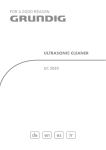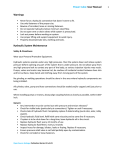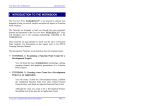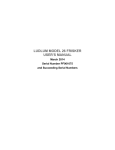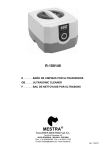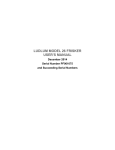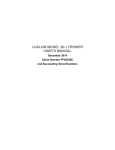Download Chicago Electric 93035 User's Manual
Transcript
DIGITAL ULTRASONIC CLEANER (FOR NONMEDICAL USAGE) Model 93035 ASSEMBLY AND OPERATING INSTRUCTIONS ® TO PREVENT SERIOUS INJURY, READ AND UNDERSTAND ALL WARNINGS AND INSTRUCTIONS BEFORE USE. 3491 Mission Oaks Blvd., Camarillo, CA 93011 Visit our Web site at: http://www.harborfreight.com Copyright© 2005 by Harbor Freight Tools®. All rights reserved. No portion of this manual or any artwork contained herein may be reproduced in any shape or form without the express written consent of Harbor Freight Tools. For technical questions and replacement parts, please call 1-800-444-3353. PRODUCT SPECIFICATIONS Electrical Input Tank Capacity Frequency Output Tank Dimensions Weight Cleaning Cycles (in seconds) 115 Volts AC / 60 Hz / 60 Watts Usage 42 oz. / 5 1/4 Cups / 1.25 L 42 KHz 2 1/2” Deep x 65/8” Long 5 Lbs. 90 / 180 / 280 / 380/ 480 Note: Not For Medical Use SAVE THIS MANUAL You will need this manual for the safety warnings and precautions, assembly, operating, inspection, maintenance and cleaning procedures, parts list and assembly diagram. Keep your invoice with this manual. Write the invoice number on the inside of the front cover. Keep this manual and invoice in a safe and dry place for future reference. GENERAL SAFETY RULES WARNING! READ AND UNDERSTAND ALL INSTRUCTIONS Failure to follow all instructions listed below may result in electric shock, fire, and/or serious injury. SAVE THESE INSTRUCTIONS WORK AREA 1. Keep your work area clean and well lit. Cluttered benches and dark areas invite accidents. 2. Do not operate power tools in explosive atmospheres, such as in the presence of flammable liquids, gases, or dust. Power tools create sparks which may ignite the dust or fumes. 3. Keep bystanders, children, and visitors away while operating a power tool. Distractions can cause you to lose control. REV 05/05 SKU 93035 For technical questions, please call 1-800-444-3353. Page 2 ELECTRICAL SAFETY 4. Grounded tools must be plugged into an outlet properly installed and grounded in accordance with all codes and ordinances. Never remove the grounding prong or modify the plug in any way. Do not use any adapter plugs. Check with a qualified electrician if you are in doubt as to whether the outlet is properly grounded. If the tools should electrically malfunction or break down, grounding provides a low resistance path to carry electricity away from the user. 5. Double insulated tools are equipped with a polarized plug (one blade is wider than the other). This plug will fit in a polarized outlet only one way. If the plug does not fit fully in the outlet, reverse the plug. If it still does not fit, contact a qualified electrician to install a polarized outlet. Do not change the plug in any way. Double insulation eliminates the need for the three wire grounded power cord and grounded power supply system. 6. Avoid body contact with grounded surfaces such as pipes, radiators, ranges, and refrigerators. There is an increased risk of electric shock if your body is grounded. 7. Do not expose power tools to rain or wet conditions. Water entering a power tool will increase the risk of electric shock. 8. Do not abuse the Power Cord. Never use the Power Cord to carry the tools or pull the Plug from an outlet. Keep the Power Cord away from heat, oil, sharp edges, or moving parts. Replace damaged Power Cords immediately. Damaged Power Cords increase the risk of electric shock. 9. When operating a power tool outside, use an outdoor extension cord marked “W-A” or “W”. These extension cords are rated for outdoor use, and reduce the risk of electric shock. PERSONAL SAFETY 10. Stay alert. Watch what you are doing, and use common sense when operating a power tool. Do not use a power tool while tired or under the influence of drugs, alcohol, or medication. A moment of inattention while operating power tools may result in serious personal injury. 11. Dress properly. Do not wear loose clothing or jewelry. Contain long hair. Keep your hair, clothing, and gloves away from moving parts. Loose clothes, jewelry, or long hair can be caught in moving parts. SKU 93035 For technical questions, please call 1-800-444-3353. Page 3 12. Avoid accidental starting. Be sure the Power Switch is off before plugging in. 13. Do not overreach. Keep proper footing and balance at all times. TOOL USE AND CARE 14. Do not overload the Ultrasonic Cleaner The Ultrasonic Cleaner will do the job better and safer at the rate for which it is designed. 15. Do not use the Ultrasonic Cleaner if the Power Switch does not turn it on or off. Any tool that cannot be controlled with the Power Switch is dangerous and must be replaced. 16. Disconnect the Power Cord Plug from the power source before making any adjustments, changing accessories, or storing the tool. Such preventive safety measures reduce the risk of starting the tool accidentally. 17. Store idle tools out of reach of children and other untrained persons. Tools are dangerous in the hands of untrained users. 18. Maintain tools with care. Do not use a damaged tool. Tag damaged tools “Do not use” until repaired. 19. Check for misalignment or binding of moving parts, breakage of parts, and any other condition that may affect the tool’s operation. If damaged, have the tool serviced before using. Many accidents are caused by poorly maintained tools. SERVICE 20. Tool service must be performed only by qualified repair personnel. Service or maintenance performed by unqualified personnel could result in a risk of injury. 21. When servicing a tool, use only identical replacement parts. Follow instructions in the “Inspection, Maintenance, And Cleaning” section of this manual. Use of unauthorized parts or failure to follow maintenance instructions may create a risk of electric shock or injury. SKU 93035 For technical questions, please call 1-800-444-3353. Page 4 SPECIFIC SAFETY RULES 1. Maintain labels and nameplates on the Ultrasonic Cleaner. These carry important information. If unreadable or missing, contact Harbor Freight Tools for a replacement. 2. Always wear ANSI approved safety impact eye goggles when using the Ultrasonic Cleaner. Use a full face shield to protect against chemical splashing. Using personal safety devices reduces the risk of injury. 3. Maintain a safe working environment. Keep the work area well lit. Make sure there is adequate surrounding workspace. Always keep the work area free of obstructions, grease, oil, trash, and other debris. Do not use a power tool in areas near flammable chemicals, dusts, and vapors. Do not use this product in a damp or wet location. 4. Never leave the Ultrasonic Cleaner unattended when it is plugged into an electrical outlet. Turn off the unit, and unplug it from its electrical outlet before leaving. 5. Never use volatile solvent to clean objects in the Ultrasonic Cleaner. Never use gasoline or other flammable liquids. 6. Never immerse the Ultrasonic Cleaner in liquid. Do not place or store the Ultrasonic Cleaner where it can fall or be pulled into a tub, sink, or other free standing pool of water. 7. Do not immerse non-waterproof products in water. 8. Do not use for medical purposes or sanitizing. 9. Do not use penetrating oils in the Cleaner as they may damage the Cleaner and any materials being cleaned. 10. Do not overfill or underfill the Cleaner. Fill water only to the MAX line when filling the tank. Never operate the cleaner unless the water level is above the MIN mark. 11. Do not clean multiple objects at a time. Using many objects in the tank at one time will cause them to bang against one another, damaging both objects being cleaned in the tank. 12. Use only lukewarm water. Excessively hot water will damage the unit. 13. Warning: Do not immerse fingers or any body part in the tub during operation. 14. Never use a cleaning agent that could create bubbles or suds that can accumulate and go up and over the edge of the cleaning tank. 15. People with pacemakers should consult their physician(s) before using this product. Electromagnetic fields in close proximity to a heart pacemaker could cause interference to or failure of the pacemaker. SKU 93035 For technical questions, please call 1-800-444-3353. Page 5 GROUNDING WARNING! Improperly connecting the grounding wire can result in the risk of electric shock. Check with a qualified electrician if you are in doubt as to whether the outlet is properly grounded. Do not modify the power cord plug provided with the tool. Never remove the grounding prong from the plug. Do not use the tool if the power cord or plug is damaged. If damaged, have it repaired by a service facility before use. If the plug will not fit the outlet, have a proper outlet installed by a qualified electrician. GROUNDED TOOLS: TOOLS WITH THREE PRONG PLUGS 1. Tools marked with “Grounding Required” have a three wire cord and three prong grounding plug. The plug must be connected to a properly grounded outlet. If the tool should electrically malfunction or break down, grounding provides a low resistance path to carry electricity away from the user, reducing the risk of electric shock. (See Figure A.) 2. The grounding prong in the plug is connected through the green wire inside the cord to the grounding system in the tool. The green wire in the cord must be the only wire connected to the tool’s grounding system and must never be attached to an electrically “live” terminal. (See Figure A.) 3. Your tool must be plugged into an appropriate outlet, properly installed and grounded in accordance with all codes and ordinances. The plug and outlet should look like those in the following illustration. (See Figure A.) FIGURE A SKU 93035 For technical questions, please call 1-800-444-3353. Page 6 DOUBLE INSULATED TOOLS: TOOLS WITH TWO PRONG PLUGS 4. Tools marked “Double Insulated” do not require grounding. They have a special double insulation system which satisfies OSHA requirements and complies with the applicable standards of Underwriters Laboratories, Inc., the Canadian Standard Association, and the National Electrical Code. (See Figure B.) 5. Double insulated tools may be used in either of the 120 volt outlets shown in the following illustration. (See Figure B.) FIGURE B EXTENSION CORDS 1. Grounded tools require a three wire extension cord. Double Insulated tools can use either a two or three wire extension cord. 2. As the distance from the supply outlet increases, you must use a heavier gauge extension cord. Using extension cords with inadequately sized wire causes a serious drop in voltage, resulting in loss of power and possible tool damage. (See Figure C, next page.) 3. The smaller the gauge number of the wire, the greater the capacity of the cord. For example, a 14 gauge cord can carry a higher current than a 16 gauge cord. (See Figure C.) 4. When using more than one extension cord to make up the total length, make sure each cord contains at least the minimum wire size required. (See Figure C.) 5. If you are using one extension cord for more than one tool, add the nameplate amperes and use the sum to determine the required minimum cord size. (See Figure C.) SKU 93035 For technical questions, please call 1-800-444-3353. Page 7 6. If you are using an extension cord outdoors, make sure it is marked with the suffix “W-A” (“W” in Canada) to indicate it is acceptable for outdoor use. 7. Make sure your extension cord is properly wired and in good electrical condition. Always replace a damaged extension cord or have it repaired by a qualified electrician before using it. 8. Protect your extension cords from sharp objects, excessive heat, and damp or wet areas. RECOMMENDED MINIMUM WIRE GAUGE FOR EXTENSION CORDS* (120 VOLT) NAMEPLATE AMPERES (At Full Load) EXTENSION CORD LENGTH 25 FEET 0 - 2.0 2.1 - 3.4 3.5 - 5.0 5.1 - 7.0 7.1 - 12.0 12.1 - 16.0 16.1 - 20.0 FIGURE C 50 FEET 18 18 18 18 16 14 12 75 FEET 18 18 18 16 14 12 10 100 FEET 16 16 16 14 12 10 - 150 FEET 16 14 14 12 10 - 16 14 12 12 - *Based on limiting the line voltage drop to five volts at 150% of the rated amperes. SYMBOLOGY Double Insulated Canadian Standards Association Underwriters Laboratories, Inc. V~ A no xxxx/min. SKU 93035 Volts Alternating Current Amperes No Load Revolutions per Minute (RPM) For technical questions, please call 1-800-444-3353. Page 8 UNPACKING When unpacking, check to make sure that the product is intact and undamaged. If any parts are missing or broken, please call Harbor Freight Tools at the number shown on the cover of this manual as soon as possible. OPERATING INSTRUCTIONS NOTE: For additional information regarding the parts listed in the following pages, refer to the Assembly Diagram on page 12. Reminder: This product is not to be used for medical or sanitizing purposes. The Ultrasonic Cleaner is designed to clean: Jewelry, Eyeglasses, Personal Hygiene items (i.e. electric shaver heads, razors, combs, dentures), Metal Tableware, Coins, Metal Parts, and other similar items. Note: Harbor Freight Tools is not responsible for the items cleaned in the Ultrasonic Cleaner. Warning: Make sure your hands are dry before contacting the Ultrasonic Cleaner. Wet hands in contact with electrical products may result in serious electrical shock. How it Works: Ultrasonic cleaning occurs when air bubbles are constantly imploded due to ultrasonic action. The result splits dirt into tiny granules, separating it from the surface of the item. 1. WARNING: Always make sure the Power Cord of the Ultrasonic Cleaner is unplugged from its electrical outlet prior to making any adjustments to the tool. 2. Open the Lid (2) and fill the Inner Tank (6) with cool water. Make sure you fill the tank above the MIN line, and below the MAX line. See FIGURE 1 below. FIGURE 1 MAX MIN 3. Place the items to be cleaned in the Inner Tank (6). If the items are very small, you may place the Basket (3) over them to keep them together. Refer to the Assembly Drawing on page 12. SKU 93035 For technical questions, please call 1-800-444-3353. Page 9 OPERATING INSTRUCTIONS (continued) 4. Insert the Plug (1) into a 115V AC outlet. 5. The digital readout on the Control Panel (5) will read at its default setting of 180 seconds. To adjust the time the unit runs, press the Set button until the desired time appears. Note: Cleaning Cycles (in seconds) are 90/ 180/ 280/ 380/ 480. Once you have set the desired cycle time, press the ON button and the Ultrasonic Cleaner will begin the cleaning cycle. The digital readout will begin to countdown toward zero. When the unit reaches zero, press the OFF button to turn off the unit. If you wish to clean an item with less than the minimum cleaning cycle of 90 seconds, simply set the time to 90 seconds, start the unit while timing the cleaning cycle yourself, and pressing the OFF button when you are ready to turn off the unit. Refer to FIGURE 2 below. 6. Always unplug the unit before removing objects. NOTE: The unit may heat the water up to about 110° F. This is perfectly normal. Use caution whenever removing the objects. FIGURE 2 Cleaning Notes: 1. If items do not come clean, you may enhance the cleaning by adding 1/4 teaspoon of mild detergent to the water. 2. If you have an item that won’t fit into the Unit, you may hold it so that the part that needs to be cleaned is submerged during the cleaning process. REV 05/05 SKU 93035 For technical questions, please call 1-800-444-3353. Page 10 INSPECTION, MAINTENANCE, AND CLEANING 1. WARNING! Make sure that the unit is unplugged from its electrical outlet before performing any inspection, maintenance, or cleaning procedures. 2. BEFORE EACH USE, inspect the general condition of the Ultrasonic Cleaner. Check for loose screws, misalignment or binding of moving parts, cracked or broken parts, damaged electrical wiring, and any other condition that may affect its safe operation. If abnormal noise or vibration occurs, have the problem corrected before further use. Do not use damaged equipment. 3. Immediately after each use, empty the Inner Tank (6). Wipe the unit clean with a dry, lint free towel. Do not submerge the unit. Submerging the unit will damage the motor. 4. Store the unit in a cool, dry place. 5. If the unit malfunctions, do not attempt to repair it yourself. Take the unit to an certified service technician. SKU 93035 For technical questions, please call 1-800-444-3353. Page 11 PARTS LIST AND ASSEMBLY DIAGRAM Part No. 1 2 3 4 5 6 Description Cord / Plug Lid Basket Housing Control Panel Inner Tank 3 6 4 5 2 1 (Plug not shown) NOTE: Some parts are listed and shown for illustration purposes only, and are not available individually as replacement parts. PLEASE READ THE FOLLOWING CAREFULLY THE MANUFACTURER AND/OR DISTRIBUTOR HAS PROVIDED THE PARTS LIST AND ASSEMBLY DIAGRAM IN THIS MANUAL AS A REFERENCE TOOL ONLY. NEITHER THE MANUFACTURER OR DISTRIBUTOR MAKES ANY REPRESENTATION OR WARRANTY OF ANY KIND TO THE BUYER THAT HE OR SHE IS QUALIFIED TO MAKE ANY REPAIRS TO THE PRODUCT, OR THAT HE OR SHE IS QUALIFIED TO REPLACE ANY PARTS OF THE PRODUCT. IN FACT, THE MANUFACTURER AND/ OR DISTRIBUTOR EXPRESSLY STATES THAT ALL REPAIRS AND PARTS REPLACEMENTS SHOULD BE UNDERTAKEN BY CERTIFIED AND LICENSED TECHNICIANS, AND NOT BY THE BUYER. THE BUYER ASSUMES ALL RISK AND LIABILITY ARISING OUT OF HIS OR HER REPAIRS TO THE ORIGINAL PRODUCT OR REPLACEMENT PARTS THERETO, OR ARISING OUT OF HIS OR HER INSTALLATION OF REPLACEMENT PARTS THERETO. SKU 93035 For technical questions, please call 1-800-444-3353. Page 12












